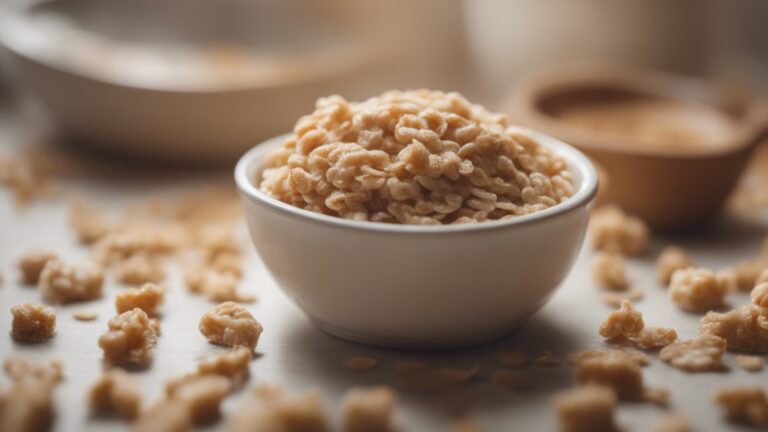
Hoisin sauce is a thick, sweet, and savory condiment made from soybeans, sugar, garlic, and spices, often used in stir-fries and as a marinade. Conversely, oyster sauce is a rich, savory sauce made from oysters, soy sauce, sugar, and sometimes cornstarch. While both sauces add depth to dishes, hoisin sauce is sweeter and more flavorful, while oyster sauce has a distinct umami taste.
In summary, hoisin sauce provides sweetness and bold flavors, while oyster sauce adds umami and richness to dishes.
| Comparison | Hoisin Sauce | Oyster Sauce |
|---|---|---|
| Taste | Sweet and tangy | Salty and savory |
| Main Ingredients | Fermented soybean paste, garlic, sugar | Oyster extracts, soy sauce, sugar |
| Usage | Marinades, glazes, dipping sauce | Stir-fries, braises, gravy |
| Consistency | Thick and sticky | Thicker than soy sauce but pourable |
| Origin | Chinese | Chinese |
The Battle of Hoisin Sauce vs. Oyster Sauce: Which One Reigns Supreme?
When adding a burst of flavor to your dishes, two popular options often come to mind, hoisin sauce and oyster sauce. Both condiments offer a unique blend of savory and sweet flavors that can elevate your dishes.
However, they have their distinct characteristics and are used in different cuisines. This article will delve into hoisin sauce and oyster sauce, exploring their origins, ingredients, flavors, and uses to help you decide which is the perfect fit for your culinary creations.
Hoisin Sauce
Originating from China, hoisin sauce is a thick, dark sauce made from soybeans, garlic, vinegar, sugar, and various spices. Its name, “hoisin,” translates to “seafood” in Chinese, but don’t be misled by the translation.
While it does contain some ingredients commonly found in seafood dishes, hoisin sauce is a versatile condiment that pairs well with various proteins and vegetables.
The distinctive flavor of hoisin sauce is a delightful balance of sweet, salty, and umami, making it a popular choice in many Asian cuisines, including Chinese, Vietnamese, and Thai. It adds a rich depth of flavor to stir-fries, marinades, barbecue sauces, and even as a dipping sauce for spring rolls or Peking duck.
Oyster Sauce
From southern China, oyster sauce is a thick, brown sauce made by simmering oysters in water and extracting their essence. The resulting liquid is thickened with starch and seasoned with salt, sugar, and sometimes soy sauce.
Despite its name, oyster sauce does not have a strong seafood taste. Instead, it offers a savory, umami flavor that enhances the natural flavors of the paired ingredients.
Oyster sauce is a staple in Cantonese cuisine and is widely used in various dishes, such as stir-fries and fried noodles, and even as a dipping sauce for steamed vegetables or dumplings. It adds a glossy sheen and a unique depth of flavor to dishes, making it a valuable ingredient in the kitchen.
Flavors and Uses
While hoisin sauce and oyster sauce share some similarities in their rich umami flavor, they have distinct tastes that appeal to different palates and work best in specific dishes.
Hoisin sauce offers a slightly sweeter and spicier profile compared to oyster sauce. Its sweetness comes from the sugar content, while its spiciness is derived from the various spices used in its preparation.
This sauce is perfect for adding a touch of sweetness and complexity to dishes like Char Siu (Chinese BBQ pork), Moo Shu Chicken, or as a glaze for grilled meats.
Oyster sauce, on the other hand, has a more savory and umami-packed taste. It brings out the natural flavors of the ingredients it is paired with and adds an unmatched depth of flavor.
This sauce is ideal for stir-fries and noodle dishes and as a finishing sauce for vegetables, giving them a glossy appearance and a burst of umami goodness.
Choosing the Right Sauce
Deciding between hoisin sauce and oyster sauce ultimately depends on the flavor profile you want to achieve and the specific dish you are preparing. Here are a few considerations to help you make the right choice:
1. Flavor:
If you prefer a sweeter and spicier flavor, hoisin sauce is the way to go. On the other hand, if you crave a savory and umami-rich taste, oyster sauce will be your best bet.
2. Dish:
Consider the dish you are making. If you are preparing a BBQ dish or something with a hint of sweetness, hoisin sauce will complement it perfectly. If you create a stir-fry or noodle dish where the flavors need to shine through, oyster sauce will be the ideal choice.
3. Cuisine:
Take into account the cuisine you are cooking. Hoisin sauce is commonly used in Chinese and Vietnamese cuisines, while oyster sauce is a staple in Cantonese cuisine. Consider the authenticity and traditional flavors when choosing the sauce.
Conclusion
Both hoisin sauce and oyster sauce bring their unique flavors and characteristics to the table. While hoisin sauce leans towards a sweeter and spicier taste, oyster sauce offers a savory and umami-packed experience. Depending on the dish and cuisine you are preparing, you can decide which sauce to use.
An experiment in your kitchen, try out different recipes and let your taste buds guide you in discovering the wonderful world of hoisin and oyster sauce.

Frequently Asked Questions
1. What is the difference between Hoisin and Oyster Sauce?
Hoisin sauce is a sweet and savory sauce made from soybeans, garlic, vinegar, and spices.
Conversely, oyster sauce is produced from oyster extracts, soy sauce, sugar, and sometimes other seasonings. Hoisin sauce has a thicker consistency and a sweeter taste than oyster sauce.
2. Can Hoisin sauce be substituted with oyster sauce?
While both sauces have different flavors, you can use oyster sauce as a substitute for hoisin sauce. However, remember that the taste will be different, and you may need to adjust the other ingredients in your recipe accordingly.
3. Is oyster sauce vegetarian or vegan?
No, oyster sauce is unsuitable for vegetarians or vegans as it is made from oyster extracts. However, vegetarian and vegan versions of oyster sauce are available that use ingredients like mushrooms instead of oysters.
4. Which sauce is more commonly used in Chinese cuisine?
Both hoisin sauce and oyster sauce are commonly used in Chinese cuisine, but hoisin sauce is used in a wider variety of dishes, including Peking duck, spring rolls, and stir-fries. Oyster sauce often enhances the umami flavor in stir-fries and noodle dishes.
5. Are hoisin and oyster sauce gluten-free?
Most hoisin sauces contain wheat as an ingredient, so they are not gluten-free. Oyster sauce also often contains soy sauce, which can include gluten. If you need a gluten-free alternative, look for specific brands that offer gluten-free versions of these sauces.
6. Can hoisin and oyster sauce be kept for a long time?
Both hoisin sauce and oyster sauce have a relatively long shelf life. Once opened, they can be stored in the refrigerator for several months to a year, depending on the brand. Check the manufacturer’s instructions and use-by dates on the packaging.
7. Can hoisin sauce be used as a dip?
Yes, hoisin sauce can be used as a dipping sauce for various foods, such as spring rolls, dumplings, and roasted meats. It adds a sweet and savory flavor that complements these dishes.
8. How can I use oyster sauce in cooking?
Oyster sauce can be used as a seasoning sauce in many Chinese recipes, particularly stir-fries and noodle dishes. It adds depth of flavor and enhances the umami taste of the dish. It can also be used as a marinade or glaze for meats and vegetables.
9. Is hoisin sauce spicy?
No, hoisin sauce is not typically spicy. It is known for its sweet and savory flavor, with hints of garlic and spices. Add chili sauce or other hot spices to the hoisin sauce if you prefer a spicier version.
10. Are the two sauces interchangeable in recipes?
While hoisin sauce and oyster sauce have distinct flavors, they can sometimes be used interchangeably in recipes if you don’t have one or the other.
However, keep in mind that the dish’s taste and texture may differ, so it’s best to use the recommended sauce if possible.






